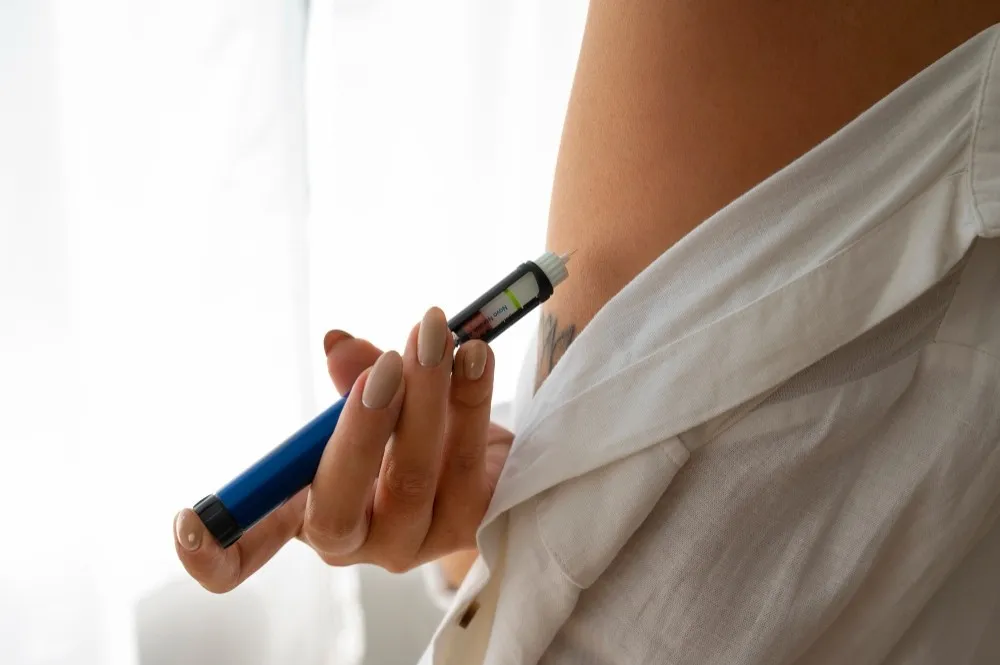Hemoglobin is a chemical found in red blood cells that aid in transporting oxygen to the body's tissues. The full name for hba1c is hemoglobin A1c, often known as HbA1c or glycosylated hemoglobin. It is a sugar-containing type of hemoglobin.
Contrary to popular belief, diabetics have greater glycosylated hemoglobin levels than non-diabetics. Thus, HbA1c tests are preferable for maintaining a stable blood sugar level.
Knowing the HbA1c normal range is important for individuals with diabetes to monitor their blood sugar levels and make necessary lifestyle changes to maintain a healthy range.
Continue Reading this article to learn what is HBa1c test, how the test work, the normal range of the test, who should have the test, and more.
 The hemoglobin A1c test determines the average blood sugar level for 2 to 3 months. It is also known as the HbA1c test, the glycated hemoglobin test, and glycohemoglobin. It's similar to a baseball player's batting average for the season since one day's test results do not provide an accurate picture of your treatment's performance.
Diabetes patients frequently require this test to ensure their levels remain within normal limits. It can inform you whether you need to change your diabetic medications. Diabetes is also diagnosed with the A1c test.
The hemoglobin A1c test determines the average blood sugar level for 2 to 3 months. It is also known as the HbA1c test, the glycated hemoglobin test, and glycohemoglobin. It's similar to a baseball player's batting average for the season since one day's test results do not provide an accurate picture of your treatment's performance.
Diabetes patients frequently require this test to ensure their levels remain within normal limits. It can inform you whether you need to change your diabetic medications. Diabetes is also diagnosed with the A1c test.
Also Read: What is Normal Glucose Levels For Adults - You Should Know
What is HBa1c Test?
 The hemoglobin A1c test determines the average blood sugar level for 2 to 3 months. It is also known as the HbA1c test, the glycated hemoglobin test, and glycohemoglobin. It's similar to a baseball player's batting average for the season since one day's test results do not provide an accurate picture of your treatment's performance.
Diabetes patients frequently require this test to ensure their levels remain within normal limits. It can inform you whether you need to change your diabetic medications. Diabetes is also diagnosed with the A1c test.
The hemoglobin A1c test determines the average blood sugar level for 2 to 3 months. It is also known as the HbA1c test, the glycated hemoglobin test, and glycohemoglobin. It's similar to a baseball player's batting average for the season since one day's test results do not provide an accurate picture of your treatment's performance.
Diabetes patients frequently require this test to ensure their levels remain within normal limits. It can inform you whether you need to change your diabetic medications. Diabetes is also diagnosed with the A1c test.
How Does the Test Work?
The sugar in the blood is known as glucose. When glucose accumulates in your bloodstream, it binds to hemoglobin in the red blood cells. The A1c test determines the amount of glucose bound in the blood. Because red blood cells survive for roughly three months, the test measures the average amount of glucose in the blood over the previous three months. Your hemoglobin A1c test will be greater if the blood sugar levels have risen high in recent weeks.| A1C(%) | Average blood sugar level (mg/dl) |
| 4 | 68 |
| 5 | 97 |
| 6 | 126 |
| 7 | 152 |
| 8 | 183 |
| 9 | 212 |
| 10 | 240 |
| 11 | 269 |
| 12 | 298 |
| 13 | 326 |
| 14 | 355 |
What Is the Normal HbA1c Range?
The HbA1c test results are given in percentages. This tells us how much of the hemoglobin has been coated with glucose. The typical range varies depending on the individual's age, comorbidities, and medical history. For example, the HbA1c range for a healthy person without diabetes is less than 5.7%. A1C levels of 5.7% to 6.4% suggest prediabetes, whereas 6.5% or above indicate diabetes. When a test result is greater than usual, even if you do not have diabetes, a follow-up test is performed to confirm the levels. A repeat HbA1c blood test or another test, such as an oral glucose tolerance test (OGTT), is performed. If you have diabetes, the normal HbA1c range is 48 mmol/mol (6.5%) or below. This is done regularly to monitor and avoid blood sugar spikes. When blood sugar levels rise, a mix of eating habits, physical activity, and medication is advised.Who Should Have The A1c Haemoglobin Test?
Everyone can get their hemoglobin A1c levels tested. A standard test for detecting glycated hemoglobin levels. If you have diabetes, it is suggested that you have an HbA1c blood test regularly. When you are below the age of 45, an HbA1c test is advised.- The findings are normal, and the test will be repeated in three years.
- The results reveal that the patient is prediabetic, and the test must be repeated every 1-2 years.
- If the findings indicate diabetes, an HbA1c test should be performed at least twice yearly.
- An HbA1c test is advised for anybody over the age of 45.
- When there is an inheritance of type 2 diabetes in the family.
- Lack of physical exercise that causes Obesity
- If you have a family history of coronary artery disease or stroke.
- High blood pressure or cholesterol levels.
- If you have prediabetes or a history of gestational diabetes, or if you have PCOS.
- Thirst, hunger, and urine frequency.
- Unexpected Weight reduction
- Having a higher number of infections than normal.
- Sores
- Dry Skin
- Blurred Vision
- Excessive tiredness.
- Hand and feet Numbness and tingling
How Regularly Do You Require the Test?
When you are diagnosed with diabetes, the doctor will check with the A1c test. You will also get the test if the doctor suspects you have diabetes. The test will establish a baseline level, allowing you to assess how effectively you regulate your blood sugar. The frequency with which you'll require the test after that is determined by several factors, including:- The type of diabetes you have
- The blood sugar management
- Your treatment strategy
- If you're diagnosed with prediabetes, which indicates a high risk of developing diabetes, you will most likely be tested once a year.
- If you suffer from type 2 diabetes, do not take insulin, and your blood sugar level is normal, you may be checked twice a year.
How can you control A1c?
For persons with diabetes, the desired A1c level is generally less than 7%. The higher your hemoglobin A1c, the greater your risk of diabetic complications. Someone who has had untreated diabetes for a long period may have a higher than 8% level. If you're diagnosed with diabetes, and your blood sugar level is higher than your target, your doctor may alter your treatment plan to bring it down. Your levels can be reduced with a mixture of diet, exercise, and medication. Diabetes patients should get an A1c test every three months to ensure their blood sugar levels are within their desired range. When your type 2 diabetes is well-controlled, then you may be able to go longer between blood tests. However, experts advise at least double-checking.What Factors Influence Haemoglobin A1c Levels?
Blood sugar levels heavily influence the amount of hemoglobin A1c. The greater the blood glucose (sugar) level, the higher the hemoglobin A1c. The higher the HbA1c number, the greater the chance of developing diabetic complications. Someone with uncontrolled diabetes for a long time may have a level greater than 8%. The following factors are responsible for changing hemoglobin A1c levels:- Consumption of glucose, either orally or intravenously.
- Fasting.
- Insulin dosage.
Conclusion -
The A1C test determines the quantity of glucose-attached hemoglobin in the blood. The test computes an average of the glucose levels in your blood over the previous three months. If your result of hba1c normal range fall within the normal range, it indicates that your average blood sugar levels have been well-controlled over the past 2-3 months. It helps to monitor blood sugar levels and to diagnose and test for prediabetes and diabetes. Diabetes patients should get an A1C test, preferably twice a year and in certain situations more frequently.
Reviewed by







